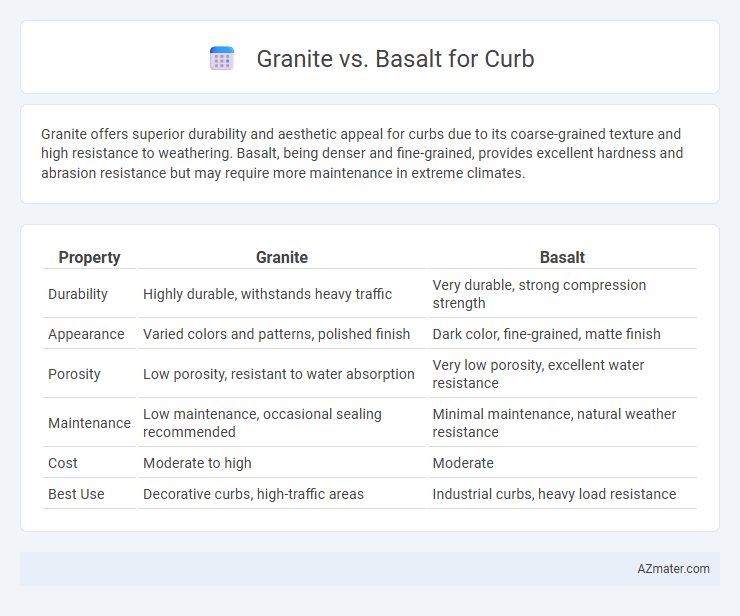Granite offers superior durability and aesthetic appeal for curbs due to its coarse-grained texture and high resistance to weathering. Basalt, being denser and fine-grained, provides excellent hardness and abrasion resistance but may require more maintenance in extreme climates.
Table of Comparison
| Property | Granite | Basalt |
|---|---|---|
| Durability | Highly durable, withstands heavy traffic | Very durable, strong compression strength |
| Appearance | Varied colors and patterns, polished finish | Dark color, fine-grained, matte finish |
| Porosity | Low porosity, resistant to water absorption | Very low porosity, excellent water resistance |
| Maintenance | Low maintenance, occasional sealing recommended | Minimal maintenance, natural weather resistance |
| Cost | Moderate to high | Moderate |
| Best Use | Decorative curbs, high-traffic areas | Industrial curbs, heavy load resistance |
Introduction: Granite vs Basalt for Curb Applications
Granite offers superior durability, with a Mohs hardness of 6-7, making it ideal for heavy-traffic curb applications where resistance to abrasion and weathering is essential. Basalt, slightly harder with a Mohs rating of 6, provides excellent compressive strength and natural slip resistance, suitable for curbs in environments requiring enhanced grip and longevity. Both stones exhibit low porosity, but granite typically delivers better aesthetic variation and long-term color retention for curb installations.
Geological Formation and Composition
Granite, an intrusive igneous rock formed from the slow cooling of magma beneath the Earth's surface, primarily consists of quartz, feldspar, and mica, giving it a coarse-grained texture and high durability for curbs. Basalt, an extrusive igneous rock created from rapid cooling of lava at the surface, is composed mainly of pyroxene and plagioclase minerals, resulting in a fine-grained, dense structure known for its hardness and resistance to wear. These geological formation and compositional differences influence their performance in curbstones, with granite offering enhanced aesthetic appeal and basalt providing superior wear resistance.
Physical Properties Comparison
Granite exhibits higher hardness and durability with a Mohs hardness of 6-7, making it resistant to scratching and weathering, while basalt ranges from 6 to 7 but generally has a denser, fine-grained structure that enhances its compressive strength. Granite's coarse-grained texture allows for better resistance to thermal expansion and contraction, whereas basalt's uniform grain size offers superior impact resistance and low porosity, reducing water absorption. Both stones possess excellent load-bearing capacities, but granite's slightly higher tensile strength and natural aesthetic make it a preferred choice for curb applications requiring long-term structural integrity.
Durability and Weather Resistance
Granite offers superior durability and weather resistance for curbs due to its coarse-grained composition and high quartz content, making it highly resistant to erosion, chipping, and freeze-thaw cycles. Basalt, an igneous rock with fine-grained texture, also provides excellent weather resistance but tends to be denser and less porous, enhancing its resistance to chemical weathering and abrasion. Both stones perform well in harsh climates, but granite's hardness and mineral stability make it the preferred choice for long-lasting curb applications.
Aesthetic Differences and Color Options
Granite offers a wide range of color options including white, pink, gray, and black, allowing for versatile aesthetic designs in curbing projects. Basalt, typically appearing in deep black or dark gray hues, provides a sleek, modern look with a more uniform texture compared to granite's varied grain patterns. The contrasting aesthetics between granite's speckled, natural appearance and basalt's smooth, consistent tone influence the visual impact and style choice for curbs.
Workability and Installation Process
Granite offers excellent workability for curbs due to its coarse-grained texture, allowing precise cutting and shaping with standard masonry tools, which facilitates a smoother installation process. Basalt, being denser and harder, requires specialized equipment for cutting and shaping, which can increase labor time and installation complexity. The difference in workability directly affects installation efficiency, with granite typically enabling faster project completion compared to the more challenging basalt.
Maintenance Requirements
Granite curbs require minimal maintenance due to their high resistance to weathering, staining, and abrasion, making them ideal for long-term durability in urban environments. Basalt curbs, while also durable, may need more frequent sealing and cleaning to prevent surface degradation and moss growth, especially in humid or wet climates. The inherent hardness and low porosity of granite reduce the need for repairs, whereas basalt's maintenance depends on environmental exposure and usage intensity.
Environmental Impact and Sustainability
Granite and basalt differ significantly in environmental impact and sustainability for curb applications; granite quarrying often results in higher energy consumption and greater landscape disruption compared to basalt, which is more abundant and typically requires less processing. Basalt's natural durability and resistance to weathering extend curb lifespan, reducing the need for frequent replacements and minimizing landfill waste. Choosing basalt supports sustainable construction practices due to its lower carbon footprint and higher recyclability relative to granite.
Cost Analysis: Granite vs Basalt Curbs
Granite curbs typically cost between $25 and $35 per linear foot, while basalt curbs range from $20 to $30 per linear foot, making basalt a more economical choice for large-scale projects. Granite offers higher durability and aesthetic appeal, often justifying its higher price for premium urban design applications. Basalt's cost-effectiveness combined with its robust hardness makes it ideal for budget-conscious infrastructure requiring long-lasting materials.
Choosing the Right Stone for Curb Usage
Granite offers exceptional durability and weather resistance, making it ideal for high-traffic curb applications requiring long-lasting performance. Basalt provides a dense, fine-grained structure with excellent load-bearing capacity and slip resistance, suitable for urban areas with heavy vehicular movement. Selecting between granite and basalt depends on specific environmental conditions, budget, and desired aesthetic, with granite favored for rugged terrains and basalt preferred for modern, smooth finishes.

Infographic: Granite vs Basalt for Curb
 azmater.com
azmater.com